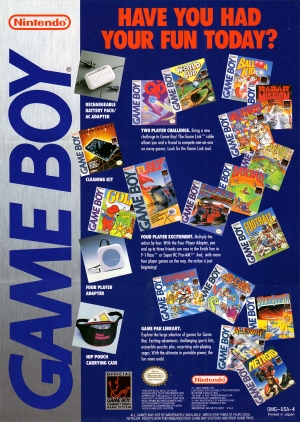
Nintendo Game Boy
Nintendo Game Boy Specifications
| Manufacturer: | Nintendo |
| Developer: | Nintendo |
| CPU: | Sharp LR35902 |
| Memory: | 8KB |
| Graphics: | 8 kB internal |
| Sound: | 2 square wave generators, 1 PCM 4-bit wave sample channel |
| Medium: | Cartridge |
| Display: | STN LCD 160 × 144 pixels |
| Controllers: | 1 |
The Game Boy, is an 8-bit handheld video game device developed and manufactured by Nintendo. It was released in Japan on April 21, 1989, in North America in August 1989, and in Europe on September 28, 1990. It is the first handheld console in the Game Boy line, and was created by Gunpei Yokoi and Nintendo Research & Development 1—the same staff who had designed the Game & Watch series as well as several popular games for the Nintendo Entertainment System.
It is Nintendo's second handheld game console and combines features from both the Game & Watch handheld and NES home system. The console features a dot-matrix screen with adjustable contrast dial, five game control buttons (a directional pad, two game buttons, and "START" and "SELECT"), a single speaker with adjustable volume dial and, like its rivals, uses cartridges as physical media for games. The color scheme is made from two tones of grey with accents of black, blue, and dark magenta. All the corners of the portrait-oriented rectangular unit are softly rounded, except for the bottom right, which is curved. At launch, it was sold either as a standalone unit, or bundled with one of several games, among them Super Mario Land and Tetris. Several accessories were also developed, including a carrying pouch, a camera, and a printer.
The original Game Boy had a monochromatic display, but it was still very popular due to its affordability and portability. It also had a long battery life, which made it ideal for gaming on the go. The Game Boy was so successful that it remained in production until 2003, when it was finally replaced by the Game Boy Advance.
The Game Boy's library of games included many classic titles, such as the Super Mario Land series, the Legend of Zelda: Link's Awakening, and Tetris. It also introduced several new franchises, such as Pokemon. The success of the Game Boy paved the way for future handheld consoles, including the Nintendo DS and the Nintendo Switch Lite.
The Game Boy received mixed reviews from critics and was deemed technologically inferior to its fourth-generation competitors (Sega's Game Gear, Atari's Lynx, and NEC's TurboExpress) due to its monochrome graphics, along with a design that was perceived as bulky by some. In spite of its perceived disadvantages, it quickly outsold the competition, selling one million units in the United States within a few weeks. An estimated 118.69 million units of the Game Boy and its successor, the Game Boy Color, have been sold worldwide, making it the fourth best-selling video game console of all time. It is one of the most recognizable devices from the 1990s, becoming a cultural icon in the years following its release. Several redesigns were released during the console's lifetime, including the Game Boy Pocket in 1996 and the Game Boy Light in 1998 (Japan only). Production of the Game Boy continued until 2003, well after the release of its second successor, the Game Boy Advance, in 2001.
Latest on Nintendo Game Boy
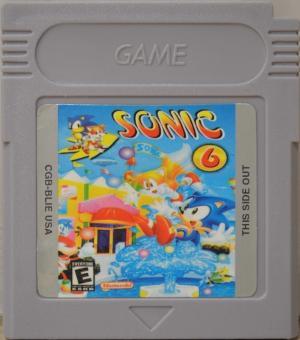
Sonic 6
Sonic 6 is an unlicensed "pirate" game for the Game Boy supposedly released in 1998. It is actually a minor graphical hack of the 1993 Speedy Gonzales...
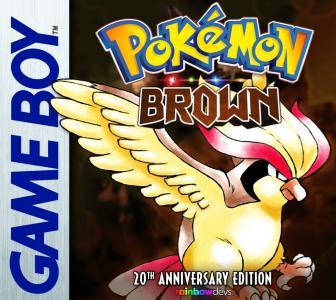
Pokémon Brown 20th Anniversary Edition
Twenty years ago, the first complete Pokémon Red mod to completely change the region and story was released. Since then, it has inspired thousands of ...
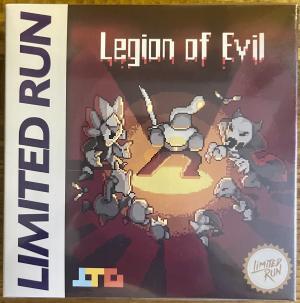
Legion of Evil
A young warlock's apprentice is lucky to survive the magical accident of his of doing. A Newt's eye looks so similar to a toad's one! It was a simp...

Submarine 9
Are you ready to captain your own submarine and dodge enemy ships in Submarine 9? Inspired by the first Game & Watch machines from the early 80s, this...

Leo Legend
Leo Legend is the first game from GreenBoy Games. As noted by the developer, Leo Legend is a very simple game, which they consider to be more of a ...

Adulting!
It's Saturday. You've survived the work week. Congratulations! Now, before you can kick back and relax for the weekend there are just a few simple thi...

Sheep It Up!
“Sheep it up!” is a one-button arcade game where a sheep has to climb up by hanging himself to flying velcro straps. The concept is simple, but the ga...

Neko Can Dream
"I heard someone's voice. It was a voice that may or may not have sounded familiar. I woke up and walked the streets hungry, looking for food." You...
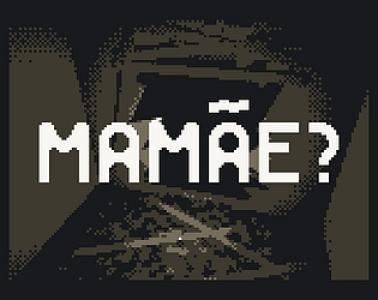
Mommy?
A 3D pre-rendered first-person Point and Click game for the GameBoy with original graphics, voice acting and story. You are in control of Lucy, her...
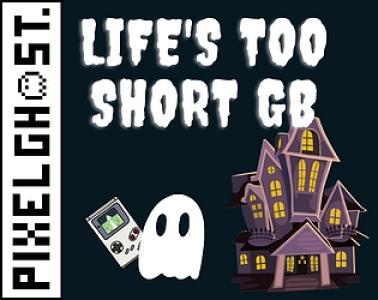
Life's Too Short GB
In Life's Too Short GB, you take on the role of a celestial problem-solver as you're tasked with repairing a rift between two vampires who have dramat...